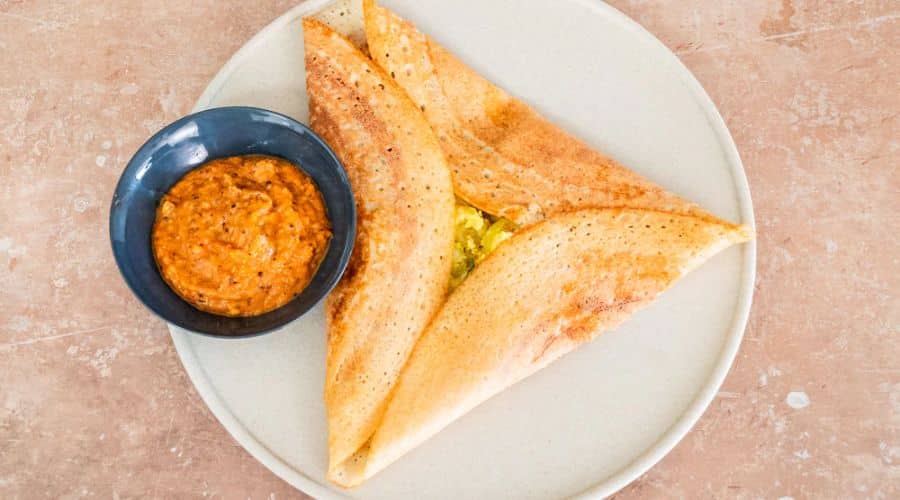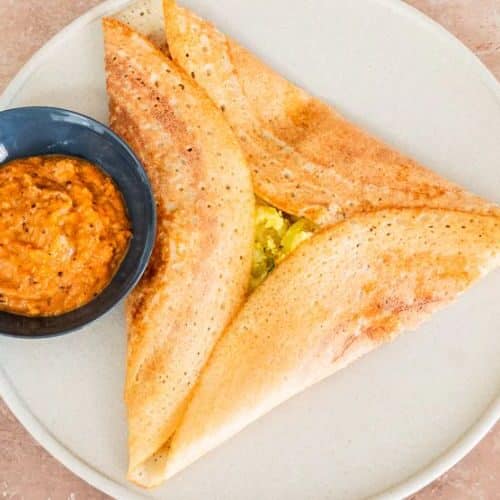Dosa is a popular South Indian dish that has become a beloved part of many cuisines around the world. Known for its crispy texture and savory flavor, dosa is often enjoyed as a breakfast or snack.
The base of dosa is a fermented batter made from rice and urad dal (black lentils), which is then spread thinly on a hot griddle to create a golden-brown, crispy pancake.
This dish is typically served with a variety of chutneys and sambar (a spicy lentil soup).
In this guide, we will walk you through the ingredients, batter preparation, and cooking techniques so you can make dosa at home with ease.

Ingredients for Making Dosa
To make the perfect dosa, you’ll need the following ingredients:
Rice
- 2 cups of rice (preferably short-grain rice or dosa rice for the best texture)
Urad Dal (Black Lentils)
- 1/2 cup of urad dal (skinless black lentils)
Fenugreek Seeds (Methi)
- 1/2 teaspoon of fenugreek seeds (optional but helps in fermentation)
Water
- Water as needed to grind the batter
Salt
- Salt to taste
Oil or Ghee
- Oil or ghee (clarified butter) for cooking the dosas
Step-by-Step Guide to Preparing the Dosa Batter

Making the batter is a crucial step in creating perfect dosas. Here’s how you can prepare it:
1. Rinse and Soak the Ingredients
Begin by rinsing the rice and urad dal thoroughly under running water. Place them separately in large bowls. Add the fenugreek seeds to the urad dal bowl. Soak both the rice and dal in plenty of water for at least 4-6 hours or overnight for the best results.
2. Grind the Batter
After soaking, drain the rice and dal. Begin grinding the dal in a wet grinder or a high-power blender, adding water gradually. Start with the dal and grind it to a smooth, creamy texture. Once it’s ready, transfer the dal into a bowl.
Now, grind the rice separately until it forms a slightly coarse paste. Combine both the rice and dal pastes in a large mixing bowl.
3. Ferment the Batter
Once the rice and dal are mixed, add salt and stir well. Cover the bowl with a clean kitchen towel or plastic wrap and leave it in a warm place to ferment for 8-12 hours, depending on the ambient temperature. The batter should rise and develop a slightly sour aroma once fermented.
How to Cook Dosa Like a Pro
Cooking dosa requires patience and practice, but with these tips, you’ll be making perfect dosas in no time.
1. Heat the Griddle or Tawa
Heat a cast iron or non-stick griddle (tawa) on medium heat. To check the temperature, sprinkle a few drops of water on the surface. If the water sizzles immediately, the griddle is ready.
2. Grease the Surface
Once the griddle is hot, lightly grease it with a small amount of oil or ghee using a paper towel or a brush. You want the surface to be well-oiled but not too slippery.
3. Pour the Batter
Pour a ladleful of batter in the center of the hot griddle. Using the back of the ladle, gently spread the batter in a circular motion, starting from the center and working your way outward, creating a thin layer.
4. Cook the Dosa
Let the dosa cook on medium heat for 2-3 minutes. The edges will begin to lift, and the bottom will turn golden brown and crispy. At this point, you can drizzle a little more oil or ghee around the edges for a crispier texture.
5. Flip or Fold
Once the dosa is crisp and golden on the bottom, you can either flip it over to cook the other side for a softer dosa or fold it immediately to serve. If you prefer crispy dosas, you don’t need to flip it.
Popular Dosa Variations
While the classic plain dosa is delicious on its own, there are numerous variations of dosa that offer unique flavors and textures. Here are some popular dosa variations you can try:
1. Masala Dosa
Masala dosa is one of the most popular dosa variations. It is a plain dosa filled with a spiced potato mixture. The potatoes are cooked with onions, mustard seeds, curry leaves, turmeric, and other spices, creating a flavorful and hearty filling. The dosa is then rolled or folded over the potato filling before serving.
2. Rava Dosa
Rava dosa is made from semolina (rava) instead of rice and dal. It results in a lighter, crispier dosa with a slightly different texture. Rava dosa is often thinner and comes with a variety of toppings like cumin, pepper, and curry leaves, making it flavorful and aromatic.
3. Onion Dosa
Onion dosa is a variation where finely chopped onions are sprinkled over the dosa while it’s cooking. The onions caramelize slightly, adding sweetness and a bit of crunch to the crispy dosa. It’s a perfect choice for those who enjoy the taste of onions.
4. Set Dosa
Set dosa is a softer, thicker version of dosa. It’s typically served in a stack of two or three dosas, making it a more filling option. Set dosa is often accompanied by sambar and coconut chutney for a delicious, comforting meal.
5. Neer Dosa
Neer dosa, a specialty from the coastal regions of India, is made with a watery rice batter, making it thinner and softer than regular dosas. It’s usually served with coconut-based curries or chutneys and is perfect for a light, easy meal.
6. Paper Dosa
Paper dosa is a larger and thinner variation, resembling a crisp sheet of paper. It is so thin that it breaks easily when rolled. This variation is typically served with a variety of side dishes and is a treat for those who enjoy an ultra-crispy dosa.
Best Side Dishes to Serve with Dosa
Dosas are often served with an array of flavorful side dishes that enhance their taste. Here are some of the best side dishes to pair with dosa:
1. Sambar
Sambar is a classic side dish that pairs beautifully with dosa. This spicy, tangy lentil soup is made with a variety of vegetables like carrots, potatoes, and drumsticks, and flavored with tamarind and sambar powder. It adds a warm, savory contrast to the crispy dosa.
2. Coconut Chutney
Coconut chutney is a refreshing, mildly spicy condiment that is often served with dosa. It’s made with fresh grated coconut, green chilies, roasted lentils, and curry leaves, offering a creamy, cooling element to balance the heat of sambar.
3. Tomato Chutney
Tomato chutney is another popular choice. It’s made by cooking ripe tomatoes with onions, garlic, and spices to create a tangy, slightly sweet, and savory chutney. It adds a burst of flavor that complements the dosa well.
4. Onion Chutney
Onion chutney is a simple yet flavorful chutney made with onions, tamarind, and spices. It has a smoky, tangy flavor that pairs well with dosas, especially the crispy varieties like paper dosa or onion dosa.
5. Potato Masala (for Masala Dosa)
The potato filling in a masala dosa is often served as a side dish too. Made with boiled potatoes, mustard seeds, curry leaves, turmeric, and other spices, this potato masala is savory and perfectly complements the crispy dosa.
6. Raita
A cooling raita made with yogurt and mixed vegetables or herbs like cucumber and mint can balance the spices of dosa. It provides a creamy, refreshing contrast to the crispy texture of the dosa.
7. Pickles
Indian pickles, made from mango, lime, or mixed vegetables, add a tangy, spicy kick to dosa. Their bold flavors enhance the dosa experience and offer a delightful contrast to the other mild side dishes.
8. Fried Papad
Fried papad (crispy lentil wafers) are sometimes served alongside dosa for an added crunch. They are light, crispy, and have a subtle spice, making them an excellent addition to your dosa meal.
Tips and Tricks for Perfect Dosas Every Time
To make sure your dosas come out crispy and delicious every time, here are some helpful tips and tricks:
1. Use the Right Ratio of Rice and Dal
The key to a perfectly textured dosa lies in the right ratio of rice to dal. A common ratio is 4:1 (rice:dal), but you can adjust it slightly depending on your preference for thickness or crispiness.
2. Ensure Proper Fermentation
Fermentation is crucial to achieving the characteristic sour flavor and light, airy texture of the dosa. Always ensure the batter is left to ferment for the right amount of time, usually 8-12 hours, depending on the climate. A warm place is ideal for fermentation.
3. Don’t Overmix the Batter
Once the batter is fermented, gently stir it before use. Over-mixing can deflate the batter and affect the texture of the dosa, making it less crispy.
4. Preheat the Griddle
Before pouring the batter, make sure your griddle or tawa is well-heated. A properly heated surface ensures that the dosa cooks evenly and crisps up perfectly.
5. Control the Thickness of the Dosa
For a crispy dosa, spread the batter thinly on the griddle. For a softer dosa, use a bit more batter and don’t spread it as thin. Adjust the heat and batter thickness to achieve your preferred texture.
6. Use a Non-Stick or Cast Iron Griddle
While a non-stick griddle requires less oil, a cast iron tawa adds flavor and a slightly crispy texture to the dosa. If using a cast iron tawa, make sure it is well-seasoned to prevent sticking.
7. Cook on Medium Heat
Cooking dosa on high heat may cause it to burn, while low heat can make it too soft. Medium heat ensures a golden, crispy dosa without overcooking.
8. Experiment with Ghee or Oil
While oil is commonly used for cooking dosas, ghee (clarified butter) gives the dosa a richer flavor and crispy texture. Experiment with both to see which one you prefer.
Conclusion
Dosa is a versatile and delicious dish that can be customized to suit any taste. Whether you prefer the classic plain dosa, a spicy masala dosa, or one of the many variations, mastering the dosa-making process will allow you to enjoy this South Indian delicacy at home. With a little practice, you’ll be making perfect dosas every time, paired with a variety of chutneys, sambar, and other delicious side dishes. So, gather your ingredients, follow the tips, and start cooking your own crispy, golden dosas!
Frequently Asked Questions
1. Why is my dosa not crispy?
If your dosa isn’t crispy, it could be due to a few reasons: the batter might be too thick, the griddle might not be hot enough, or the batter may not have fermented properly. Make sure the batter is spread thinly, the griddle is well-heated, and the batter has been fermented for the right amount of time.
2. Can I use store-bought dosa batter?
Yes, store-bought dosa batter can be used as a convenient alternative, but homemade batter tends to yield better results, especially when it comes to texture and flavor. If using store-bought batter, ensure it’s fresh and properly fermented before cooking.
3. Can I make dosa batter in a food processor?
While a wet grinder is traditionally used for grinding dosa batter, a high-power food processor can also be used. However, it may not provide the same smoothness and texture that a wet grinder can achieve.
4. How do I store leftover dosa batter?
Leftover dosa batter can be stored in an airtight container in the refrigerator for up to 2-3 days. Make sure to bring it to room temperature before using it again, and stir gently before cooking.
5. Can I make dosa with gluten-free ingredients?
Yes, you can make gluten-free dosa by using rice and urad dal as the base ingredients. However, be cautious if you plan to make variations like rava dosa, as semolina (rava) contains gluten. Stick to rice-based batters for gluten-free dosas.

Dosa
Equipment
- Wet grinder or food processor – 1 (for grinding the batter)
- Griddle or tawa – 1 (for cooking dosas)
- Ladle – 1 (for pouring batter)
- Spatula – 1 (for flipping and folding)
- Measuring cups and spoons – 1 set (for accurate ingredient measurements)
- Mixing bowl – 1 (for fermenting the batter)
- Oil or ghee brush – 1 (for greasing the griddle)
Ingredients
For the Dosa Batter:
- 2 cups Rice preferably short-grain or dosa rice
- 1/2 cup Urad dal black lentils
- 1/2 teaspoon Fenugreek seeds optional
- Water as needed, for grinding the batter
- Salt to taste
For Cooking:
- Oil or ghee as needed for greasing the griddle
Instructions
Soak the Ingredients:
- Rinse the rice and urad dal separately. Add the fenugreek seeds to the urad dal bowl. Soak them in plenty of water for at least 4-6 hours or overnight.
Grind the Batter:
- Drain the soaked rice and dal. Grind the dal first in a wet grinder or food processor to a smooth paste, adding water gradually. Then, grind the rice into a slightly coarse paste.
- Combine both rice and dal pastes in a large mixing bowl and stir in salt.
Ferment the Batter:
- Cover the bowl with a cloth and let the batter ferment in a warm place for 8-12 hours. The batter should rise and develop a slightly sour smell when it’s ready.
Cook the Dosas:
- Preheat the griddle or tawa on medium heat. Once hot, lightly grease it with oil or ghee using a brush or paper towel.
- Pour a ladle of batter in the center and spread it into a thin circle using the back of the ladle.
- Let the dosa cook for 2-3 minutes, until the edges begin to lift and the bottom turns golden brown and crispy.
- Optional: Add a little oil or ghee along the edges for extra crispiness.
- Fold or serve the dosa as desired.
Serve:
- Serve the dosa hot with coconut chutney, sambar, or any side of your choice.
Notes
- Fermentation Tip: The batter should ferment in a warm area. If you live in a colder climate, you can place the batter in an oven with just the light on, or wrap the bowl in a warm cloth to speed up the fermentation process.
- Griddle Temperature: Ensure the griddle is not too hot, or the dosa will burn. It should be medium-hot, and you should hear a slight sizzle when the batter hits the surface.
- Gluten-Free Option: Dosa is naturally gluten-free, so it’s suitable for those with gluten intolerance.
- Storage: Leftover batter can be stored in the fridge for up to 2-3 days. Stir gently before using. Dosas made from freshly fermented batter yield the best texture.

